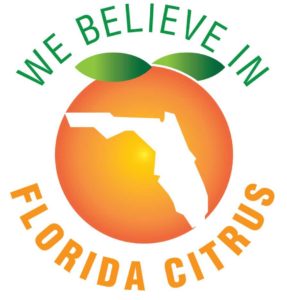Citrus growers in Florida know the statistics on the impact that HLB has had all too well. Production down by more than 70% and acreage dipping below a half-million acres. Estimates for this season also point to another year-over-year decline in production. Despite the scale of damage brought by HLB, citrus growers remain persistent and believe the industry can survive into the future — and thrive — once more permanent solutions to the disease, spread by the tiny Asian citrus psyllid, are found.
It is easy to lose sight of that when challenges have been so great. For that reason, Florida Grower® magazine has initiated the “We Believe in Florida Citrus” program to shine a light on the positives happening in the state’s citrus industry.
There are plenty of reasons to believe. First and foremost, we believe in Florida citrus because of you and the innovations you’ve developed in your own groves. Many of these involve plant nutrition, which focuses on tree and root health. These programs have helped keep trees productive for far longer than they would have otherwise.
You are planting trees. No doubt we need more planting, but many of you are illustrating your confidence by putting trees in the ground. You are taking advantage of planting programs like the Citrus Research and Field Trials (CRAFT) project.
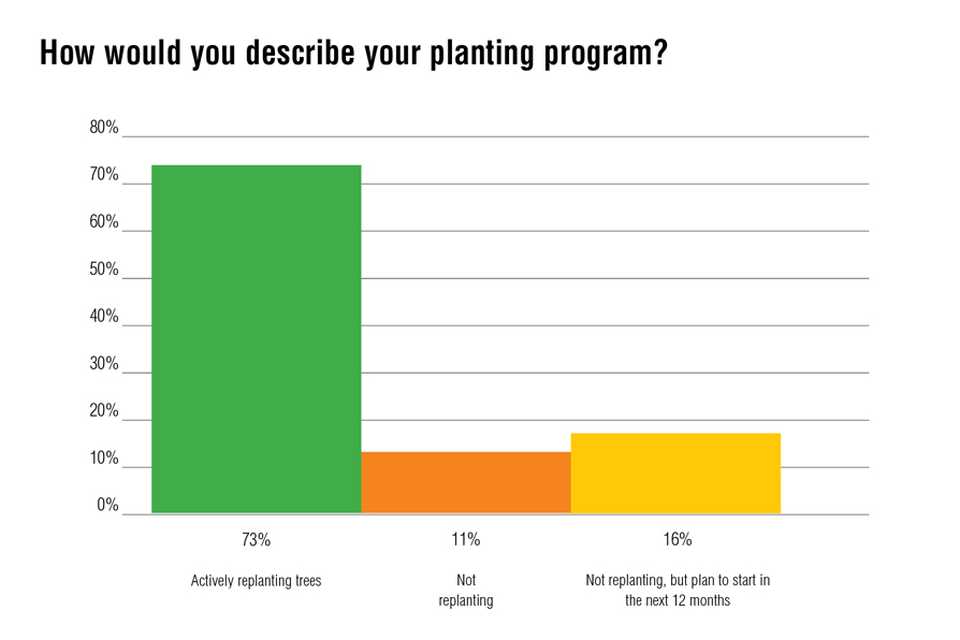
Survey results from last year’s Florida Grower Citrus Industry Pulse survey show growers are actively planting.
CRAFT will provide incentives for about 5,000 acres of new plantings. Data will be collected on the production practices, tree health, and yields for six years. It should help growers put a finer point on what’s working best in the many different programs developed over the years.
Breakthroughs in Sight?
Rick Dantzler has been on the front lines of the battle against HLB in his role as Chief Operating Officer of the Citrus Research and Development Foundation (CRFD). He believes in Florida citrus. In fact, he says, “You are darn right I do. If I had the money and was a little younger, I’d jump in with both feet.”
Dantzler says the scope of the research effort to defeat the menace has been huge. Estimates suggest about $1.4 billion has been spent on research nationally. Florida has funded 462 projects at a cost of nearly $141 million.
“There is simply no way that HLB will win with this kind of assault,” Dantzler says. “Sooner or later it will be eradicated or made functionally irrelevant. CRDF’s job is to make it sooner rather than later.”
CRDF exemplifies that, as growers, you have skin in the game. You have imposed a 3-cents-per-box tax on production to fund research projects that are vetted, debated, voted on, and approved by CRDF’s grower committees. As production has declined, the state legislature has stepped up and provided funds to help make up the difference in declining box tax revenue.
As to specific breakthroughs, Dantzler says there’s promising work on several different fronts. The development of HLB-tolerant rootstocks and scions is major among them.
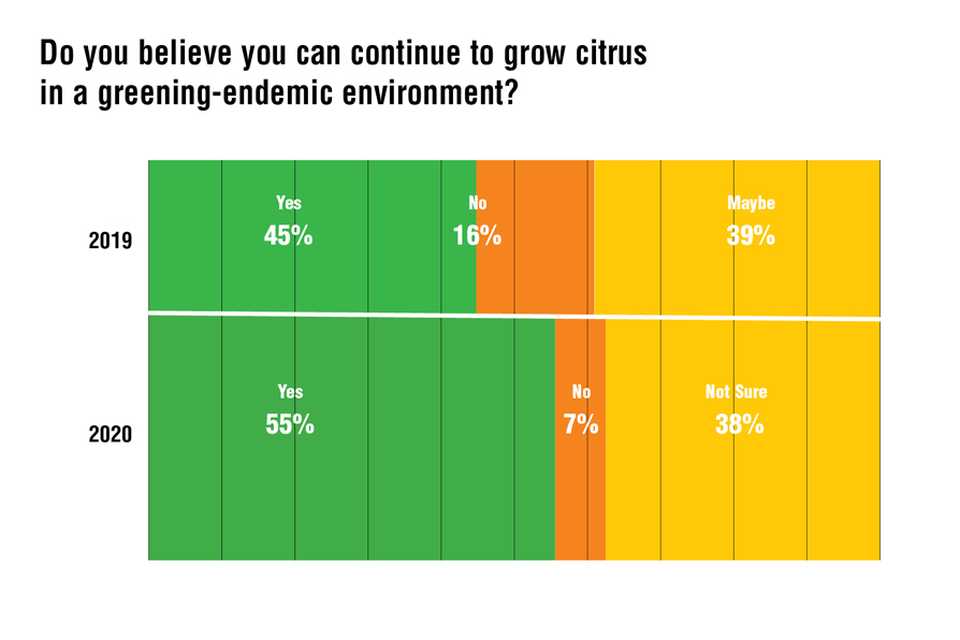
A majority of citrus growers in Florida indicated a belief in the ability to grow the crop despite HLB — those figures were up over the previous year’s Florida Grower Citrus Industry Pulse survey.
“We are seeing some really good stuff in these new selections,” he says. “The problem is there are so many new creations, I’m not sure we know what we have because they haven’t been tested to determine if they work commercially. CRDF is going to fix that. We have decided to do our own last-stage rootstock and scion trials and find out.”
The buzzword of 2021 is “peptides.” What is a peptide? It is a small chain of amino acids. For context, proteins are longer chains of amino acids. Scientists are beginning to understand how peptides work and, more importantly, how they can be used for the good in fighting diseases like HLB. Dantzler is convinced peptides will be a tool in your HLB-fighting toolbox.
“I nearly get laughed out of some rooms when I say this, but tree injection (of peptides or other materials) is a technology that could change every-thing,” he says. “Getting to the liberibacter (HLB bacteria) in the phloem of the citrus tree, where it lives, is tough because of the waxy surface of the leaves and the difficulty of piercing the wall of the phloem, but the right injection device could do it. And what if we worked on getting into the phloem from the xylem instead of from the outside? Would that work? And what if we could come up with an injection device that we could leave in the tree for 10 years? I know tree injection is currently too expensive, but so was a pocket calculator 50 years ago, and now they are given away free.”
Shorter-term, CRDF has funded research that should yield new recommendations to help reduce fruit drop, which has been an increasing problem in recent years — this season included.
Market Rebound
There was good news during the 2019-2020 crop season as the down market began to turn around when foreign juice contracts ran their course after the impact of Hurricane Irma. Consumers also were reminded of the health and immunity benefits of orange juice.
“The coronavirus has had a big stimulative effect on OJ NFC (not from concentrate) sales, which is why Florida NFC inventories are declining rapidly,” says Bob Behr, CEO of Florida’s Natural Growers. “Consumers are eating at home more, so they have increased their purchases of our products in grocery stores. In addition, our products have a health benefit (immunity defense), which is helping.”
Team Effort
The fight to defeat HLB is a team effort. Growers, scientists, commercial suppliers, and other industry stakeholders have a role to play in saving the state’s signature crop.
“I’ve sometimes heard it said that growers claim to have discovered new things and researchers prove them right or wrong,” Dantzler adds. “There is some truth to that. Growers talk in the coffee shop about what they think is working, and that makes its way back to researchers who figure out if that is correct or not. Research is a symbiotic relationship — or should be — between growers and researchers.”
All these efforts, along with sophisticated science developing tools like peptides and genetic technologies like CRISPR, all promise a sustainable future. Those solutions can’t come quickly enough, but as Windermere-based grower Glenn Beck puts it — in the meantime, do what you can.
“My advice is to do what you can afford and stay engaged if at all possible,” Beck says. “You might not bring every tree through HLB, but a lot of them, you will. It is as much about the passage of time as it is all of the inputs you apply to a grove.”
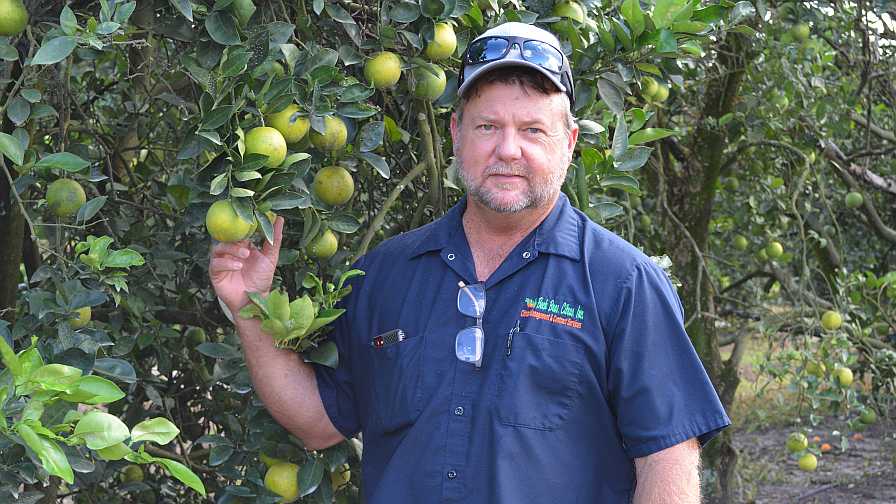
Glenn Beck believes in Florida citrus. He and his brother, Mark, have kept on a good management program that includes planting ever since HLB came on the scene.
Photo by Frank Giles
Beck is doing many of the same things other growers are doing to make the HLB-infected trees feel and perform better, with plant nutrition being a central player. The key, Beck says, is getting on a good, basic production program and sticking with it to allow time for trees to respond.
“When HLB started to spread and we realized how bad it would be, some people decided they were not going to plant until some breakthrough treatment or resistant tree came along,” Beck says. “Well, 15 years later, those folks are still waiting. We need to plant trees today. This industry has gotten too small to supply our juice demand.”
Planting trees and increasing production at competitive, sustainable prices, combined with marketing to grow consumption, are keys to the future of Florida citrus.
“We believe it’s something that can be done, and we’ve approached our business that way ever since HLB came along,” Beck says. “We Believe in Florida Citrus.”
Citrus Show Made for Believers
The Florida GrowerSM Citrus Show was rescheduled from its original dates in February to May 12-13 due to the coronavirus. The show planners are hard at work to host a safe, in-person event in May.
This year’s event will be themed, “We Believe in Florida Citrus” in keeping with Florida Grower’s larger initiative. The show has been a longtime and successful partnership among the magazine and UF/IFAS, the Indian River Citrus League, and USDA to provide growers an opportunity to learn about the latest research and market intelligence.
“When you step back and look at all the research being conducted on behalf of the Florida citrus grower, it truly is impressive,” says Dr. Rhuanito “Johnny” Ferrarezi, a UF/IFAS Extension Citrus Horticulturalist and Citrus Show Program Chairman. “The Show’s educational sessions will feature many exciting frontiers of this research. It will be a great value for attendees. We are excited to do this work on behalf of our growers because we believe in Florida citrus.”
The show will place a priority on safety and follow COVID-19 protocols. For instance, the education space and trade show floor will be designed to allow for social distancing, and registration will be limited and focused on serving grower attendees first.
As always, the trade show will feature commercial suppliers of the products and services you need to grow a sustainable crop and to run a successful business.
These specific actions, agenda, and other show details are available on CitrusShow.com and via other channels.
Stay tuned for updates on the show, as it is a fluid situation with changing conditions.
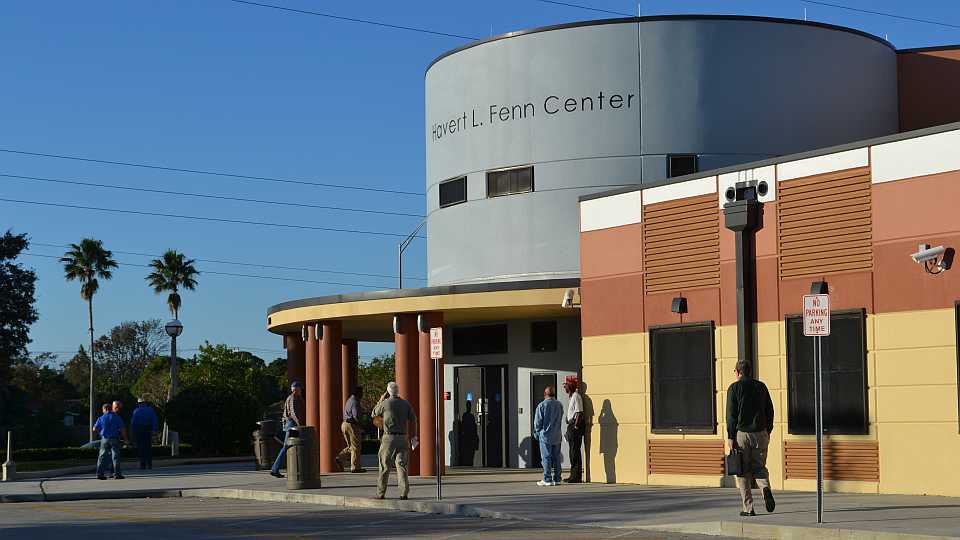
The Havert L. Fenn Center in Ft. Pierce will once again serve as home base for the Florida Citrus Show.
Photo by Paul Rusnak
Education Program Highlights
At posting, the agenda was being finalized, but here are a few highlights to look forward to:
• New varieties and rootstocks
• Speeding up new variety development
and release
• New frontiers in peptides
• HLB and other disease management
• Psyllid and other pest management
• Proper micronutrient levels and proper delivery methods in HLB-affected trees
• Best management strategies for automated irrigation systems
• Antimicrobials and delivery mechanisms
• Planting incentive program update
• Citrus Research and Development Foundation updates
• And much more










